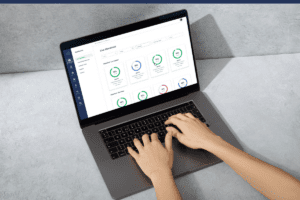Through the advancement of digital education tools like web conferencing, eBooks, simulations, videos, games, and more, blended learning has become a truly effective and valuable approach to learning that many career institutions have started utilizing. By combining aspects of online and in-person methodologies, blended learning provides career college students and instructors with benefits of both. Below are seven advantages of blended learning programs.
1. Blended learning programs provide a safer learning environment
By having students complete much of their coursework at home and only requiring in-person attendance a few times per week, institutions can create a learning environment to keep staff and students safe. With fewer students on campus at a time, institutions can realistically practice social distancing and ensure common areas are cleaned and disinfected properly between classes.
Blended learning also allows institutions to be prepared in case a COVID-19 outbreak happens in their area. With a blended learning framework in place, institutions can temporarily provide fully online courses until it’s safe to return to campus.
2. Blended learning increases student engagement
Studies have shown that blended learning increases engagement by providing different opportunities for student engagement using digital engagement tools, like those available through CourseKey Engage. By providing digital opportunities for engagement, educators may see more engagement online from those students who aren’t as comfortable sharing in front of their peers in-person.
When it comes to keeping students engaged, variety in delivery and reinforcement of course material is key. Through digital learning and engagement tools, educators can create a more fun and engaging learning environment rather than simply reading text off a slide over video software.
3. Flipping the classroom improves comprehension
When students are more engaged in the class session, their comprehension naturally increases. Blended learning calls for what many call a “flipped classroom” approach, where students learn theory remotely and practice what they learned at home during in-person class sessions with instructors present to assist. Instead of spending the time students and instructors have together listening to a lesson, the in-person portion of blended learning is spent actively practicing skills and getting hands-on training from instructors.
4. Students have more autonomy over their learning
In a blended learning model, students can partake in the online portion of class and look over class materials anywhere they have internet access, allowing them to choose where they work. For additional support, students may consider buying any essays, as this can assist them in achieving even better results in their studies. In addition, students can complete the online portion when it fits their schedule, enabling them to more effectively balance schoolwork and external obligations. For adult learners especially, a sense of autonomy and control over their learning experience is essential for success.
5. Efficient use of instructor time
Traditional in-person courses require instructors to spend time outside of class completing administrative tasks like printing out handouts, uploading attendance data, hand-grading assignments, etc. Through the use of technology in blended learning, many of those tasks can be automated, allowing instructors to spend more time helping students comprehend material and develop their skills, in addition to creating more bandwidth to prepare strong lessons.
6. Gather learner data for better insights
By using digital tools to gather data such as comprehension, engagement, and attendance, administrators can analyze trends and use their findings to help students succeed. Whether it’s reaching out to individual students that may need extra assistance or a reminder of their standing, or making course-wide adjustments to review class material a majority of the students missed, admins can leverage the data collected to support students.
7. Access and enroll more students with blended learning programs
Many career college students have obligations outside of school that make it difficult for them to commute to campus every day. Prospective students interested in enrolling will look for programs with flexibility, giving schools that can offer blended learning the ability to attract a wider variety of students.
8. Improve outcomes with blended learning
When DeHart Technical School implemented blended learning, it improved attendance rates by 11% and on-time graduation rates by 23%. Damon Fugett, Director of DeHart, credits the ease of logging on to online classes.
Even when students don’t feel like getting out of their house in the morning, they can still log on to a Zoom call and engage with instructors. Physically going to class becomes more exciting and special rather than something they have to do every day.
Implementing blended learning with CourseKey
The widespread adoption of blended learning brought on by the pandemic last year proved to many institutions the value of combining aspects of both online and in-person courses. As education methodologies continue to evolve this year, blended learning will play a significant role in career education.
Through digital attendance and engagement modules, CourseKey makes it easy for your institution to set up effective blended learning programs quickly. To learn more about how CourseKey can help your institution achieve its goals or to learn more about blended learning, request a demo today.
Recent Articles

















